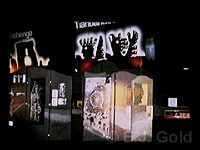 One of the main attractions of Strange, Strange World had always been its presentation of archaeological anomalies and strangenesses. Many questions remain unanswered in the vast domain of things past. Many keys have been thrown away, and pieces of the puzzle have been scattered over millenia. And so Strange, Strange World tried to take a fresh look at ancient civilizations, their beliefs and achievements, their knowledge and wisdom, their engineering and magic. This was long before the documentary series In Search Of, Believe It or Not, or the X-Files, or anything far-out like that on TV. It simply didn't exist.
One of the main attractions of Strange, Strange World had always been its presentation of archaeological anomalies and strangenesses. Many questions remain unanswered in the vast domain of things past. Many keys have been thrown away, and pieces of the puzzle have been scattered over millenia. And so Strange, Strange World tried to take a fresh look at ancient civilizations, their beliefs and achievements, their knowledge and wisdom, their engineering and magic. This was long before the documentary series In Search Of, Believe It or Not, or the X-Files, or anything far-out like that on TV. It simply didn't exist.
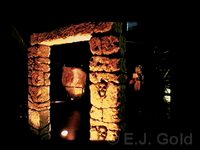 Impressive reproductions to ponder included a 3-ton Easter Island statue, an ornate eight-foot gallic temple entrance with imbedded decorative skulls, and a fifteen-foot copy of the Palenque slab from Mexico made famous by Eric Von Daniken and his Chariots of the Gods?
Impressive reproductions to ponder included a 3-ton Easter Island statue, an ornate eight-foot gallic temple entrance with imbedded decorative skulls, and a fifteen-foot copy of the Palenque slab from Mexico made famous by Eric Von Daniken and his Chariots of the Gods?
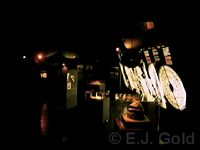 Smaller models of equal interest were Stonehenge, the BigHorn Medecine Wheel, Serpent Mound in Ohio, Teotihuacan, an Omphalos from an Oracle Center in the ancient world which had functioned for thousands of years, the provocative remains of a statue of a fish-man called Oannes by the Babylonians and known to the Dogon in Africa today, and North American petroglyphs that mark the beginnings of astronomy on this continent.
Smaller models of equal interest were Stonehenge, the BigHorn Medecine Wheel, Serpent Mound in Ohio, Teotihuacan, an Omphalos from an Oracle Center in the ancient world which had functioned for thousands of years, the provocative remains of a statue of a fish-man called Oannes by the Babylonians and known to the Dogon in Africa today, and North American petroglyphs that mark the beginnings of astronomy on this continent.
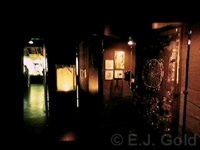 Several models transported visitors into the theme of the Earth Spirit as it was elegantly developed by researcher John Michell in a book of his titled, The Earth Spirit. A fertilizing stone from Brittany, a healing stone from England--perhaps meteoritic?--a cavern used for initiations and vision quests. Was this folklore or traditional knowledge? Was it myth or wisdom? Ley lines, fairy paths and geomancy were other related topics that found their way into the exhibit and exercised much fascination on visitors.
Several models transported visitors into the theme of the Earth Spirit as it was elegantly developed by researcher John Michell in a book of his titled, The Earth Spirit. A fertilizing stone from Brittany, a healing stone from England--perhaps meteoritic?--a cavern used for initiations and vision quests. Was this folklore or traditional knowledge? Was it myth or wisdom? Ley lines, fairy paths and geomancy were other related topics that found their way into the exhibit and exercised much fascination on visitors.
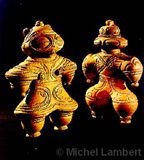 Artifacts and curiosities included some fairy coffins, a crystal skull, Dogu statuettes, the Antikythera mechanism (an ancient calculator), an authentic Kachina costume, the Phaistos Discus, Mayan airplanes (or flies, whichever you prefer), "Ezekiel's wheel", the Manna machine, and many other perplexing and amusing finds.
Artifacts and curiosities included some fairy coffins, a crystal skull, Dogu statuettes, the Antikythera mechanism (an ancient calculator), an authentic Kachina costume, the Phaistos Discus, Mayan airplanes (or flies, whichever you prefer), "Ezekiel's wheel", the Manna machine, and many other perplexing and amusing finds.
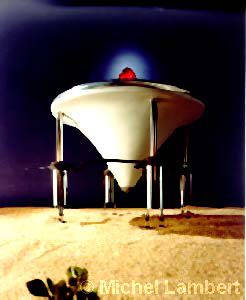 The archaeological exhibit attempted to capture the mood of antiquity, of things buried and was accordingly designed in earth tones. We produced large display panels with soil layering that were loaded very heavily with sand and earth and looked quite convincing. The light was golden yellow and glowingly mysterious. The music we played was Paul Horn's Inside the Great Pyramid.
The archaeological exhibit attempted to capture the mood of antiquity, of things buried and was accordingly designed in earth tones. We produced large display panels with soil layering that were loaded very heavily with sand and earth and looked quite convincing. The light was golden yellow and glowingly mysterious. The music we played was Paul Horn's Inside the Great Pyramid.
 Impressive reproductions to ponder included a 3-ton Easter Island statue, an ornate eight-foot gallic temple entrance with imbedded decorative skulls, and a fifteen-foot copy of the Palenque slab from Mexico made famous by Eric Von Daniken and his Chariots of the Gods?
Impressive reproductions to ponder included a 3-ton Easter Island statue, an ornate eight-foot gallic temple entrance with imbedded decorative skulls, and a fifteen-foot copy of the Palenque slab from Mexico made famous by Eric Von Daniken and his Chariots of the Gods?  One of the main attractions of Strange, Strange World had always been its presentation of archaeological anomalies and strangenesses. Many questions remain unanswered in the vast domain of things past. Many keys have been thrown away, and pieces of the puzzle have been scattered over millenia. And so Strange, Strange World tried to take a fresh look at ancient civilizations, their beliefs and achievements, their knowledge and wisdom, their engineering and magic. This was long before the documentary series In Search Of, Believe It or Not, or the X-Files, or anything far-out like that on TV. It simply didn't exist.
One of the main attractions of Strange, Strange World had always been its presentation of archaeological anomalies and strangenesses. Many questions remain unanswered in the vast domain of things past. Many keys have been thrown away, and pieces of the puzzle have been scattered over millenia. And so Strange, Strange World tried to take a fresh look at ancient civilizations, their beliefs and achievements, their knowledge and wisdom, their engineering and magic. This was long before the documentary series In Search Of, Believe It or Not, or the X-Files, or anything far-out like that on TV. It simply didn't exist.


 The archaeological exhibit attempted to capture the mood of antiquity, of things buried and was accordingly designed in earth tones. We produced large display panels with soil layering that were loaded very heavily with sand and earth and looked quite convincing. The light was golden yellow and glowingly mysterious. The music we played was Paul Horn's Inside the Great Pyramid.
The archaeological exhibit attempted to capture the mood of antiquity, of things buried and was accordingly designed in earth tones. We produced large display panels with soil layering that were loaded very heavily with sand and earth and looked quite convincing. The light was golden yellow and glowingly mysterious. The music we played was Paul Horn's Inside the Great Pyramid.
